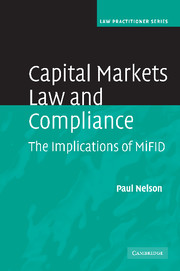Book contents
- Frontmatter
- Contents
- Preface
- List of acronyms
- Part I Evolution of capital markets regulation, FSA and the European single market
- Part II Licensing and rule application
- Part III The firm's infrastructure
- 5 Systems and controls
- 6 Conflicts of interest
- 7 Client property
- Part IV Conduct of business
- Part V Application of rules to particular businesses
- Bibliography
- Index
7 - Client property
Published online by Cambridge University Press: 03 December 2009
- Frontmatter
- Contents
- Preface
- List of acronyms
- Part I Evolution of capital markets regulation, FSA and the European single market
- Part II Licensing and rule application
- Part III The firm's infrastructure
- 5 Systems and controls
- 6 Conflicts of interest
- 7 Client property
- Part IV Conduct of business
- Part V Application of rules to particular businesses
- Bibliography
- Index
Summary
Client assets and custody
Protecting the client's assets
Pre-MiFID:Ever since the 1986 FSAct regime, ‘[i]nvestors have a right to the assurance that their assets are properly safeguarded while they are under the control of a [firm]’and, thus, ‘[t]he ultimate safeguard for investors is the assurance that on the failure of the [firm] … their … investments … are recoverable by them … [T]his can be achieved only by … segregation of clients’… investments from the firm's … investments … in such a way that ownership remains with [the client].’ Hence, a ‘safe custody investment’ was ‘a designated investment, which is not the property of the firm, but for which the firm or any nominee/company controlled by the firm or by its associate is accountable; which has been paid for in full by the client; and which … the firm has [not] disposed of… in accordance with a valid instruction’ and in respect of which the firm was conducting the licensable activity of custody (3.2.2.6) in or from the UK or an EEA branch (but not a non-EEA branch) with Private Customers, Intermediate Customers, or Market Counterparties.
- Type
- Chapter
- Information
- Capital Markets Law and ComplianceThe Implications of MiFID, pp. 194 - 222Publisher: Cambridge University PressPrint publication year: 2008



